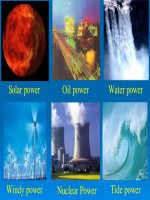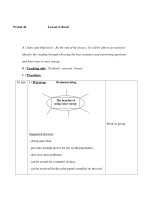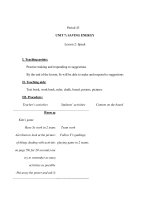Unit 7: Saving Energy ( Read) ( qua dinh)
Bạn đang xem bản rút gọn của tài liệu. Xem và tải ngay bản đầy đủ của tài liệu tại đây (991.22 KB, 11 trang )
Cross words
Choose the numbers and find the words and the key word
KEY WORD
1
2
3
4
5
6
E L E C T R I C I T Y
C O U N T R Y
S A V E
WA T E R
G A S
C I T Y
Familieswhere to make light andthanmachines
TheUsing itYoucooking,aremany high buildings and traffic
place use use it are paddy fields usual
forYou use less things cars, etc….
there wash, bathe,
The place whereitthere to motorbike, foretc…
Look at these pictures and answer the questions
Gas
Water
* Questions:
1. Are gas, water, electriccity necessary?
2. What do you do to save gas?
3. What do you do to save water?
4. What do you do to save electricity?
Electricity
Unit 7: Saving energy
5. READ
L
C
H
A
L
T
I
In Western countries, electricity, gas, and water are not
Luxury > < Necessityluxeries but necessities. Companies now realize that
Consumer (n) : User of product or service.
consumers want products that will not only work
effectively, but also save money.
Household (n) : family.
For most North American households, lighting account
Account for (v) : represent.
for 10 percent to 15 percent of the electricity bill.
Labeling scheme (n) : However, this amount can be products. by replacing an
campaign that gives labels to reduced
ordinary 100-watt light bulb with an energy-saving bulb.
These bulbs use a quarter of the electricity of standard
bulbs and last eight times longer. Therefore consumers
can save about US$7 to US$21 per bulb.
In Europe, there is a labeling scheme for refrigerators,
Tumble dryer (n) : machine that drys things usually hair or clothes.
freezers, washing machines and tumble dryers. The
label tells the consumers how much energy efficiency
each model has, compared with other appliances in the
same category.
Ultimately, these innovations will save money as well
Inovation (n) : bringing in new ideas, making change.
as conserve the Earth’s resources
Unit 7: Saving energy
5. READ
•
•
•
•
In Western countries, electricity, gas, and
water are not luxeries but necessities.
Companies now realize that consumers
want products that will not only work
effectively, but also save money.
For most North American households,
lighting account for 10 percent to 15
percent of the electricity bill. However, this
amount can be reduced by replacing an
ordinary 100-watt light bulb with an
energy-saving bulb. These bulbs use a
quarter of the electricity of standard bulbs
and last eight times longer. Therefore
consumers can save about US$7 to
US$21 per bulb.
In Europe, there is a labeling scheme for
refrigerators, freezers, washing machines
and tumble dryers. The label tells the
consumers how much energy efficiency
each model has, compared with other
appliances in the same category.
Ultimately, these innovations will save
money as well as conserve the Earth’s
resources
100-watt light bulb
Electricity bill
Refrigerator
Energy-saving light
bulbs
Freezer
Washing machine
Unit 7: Saving energy
5. READ
a) Which of the following is the best summary of the passage?
1. Energy- saving bulbs should be
used to save electricity.
2.
In
Western
countries
electricity, gas, and water are
necessities.
3. North American and European
countries are interested in saving
money and natural resources.
4. Labeling schemes help save
energy
* Explanation
=> 3 is the best answer because
three others are too specific. They
only cover one part of the passage.
In Western countries, electricity, gas, and water
are not luxeries but necessities. Companies now
realize that consumers want products that will not
only work effectively, but also save money.
For most North American households, lighting
account for 10 percent to 15 percent of the
electricity bill. However, this amount can be
reduced by replacing an ordinary 100-watt light
bulb with an energy-saving bulb. These bulbs
use a quarter of the electricity of standard bulbs
and last eight times longer. Therefore consumers
can save about US$7 to US$21 per bulb.
In Europe, there is a labeling scheme for
refrigerators, freezers, washing machines and
tumble dryers. The label tells the consumers how
much energy efficiency each model has,
compared with other appliances in the same
category.
Ultimately, these innovations will save money as
well as conserve the Earth’s resources
Unit 7: Saving energy
5. READ
b) Answer the questions. Write the answers in your exercise book
•
•
•
•
In Western countries, electricity, gas, and
water are not luxeries but necessities.
Companies now realize that consumers
want products that will not only work
effectively, but also save money.
For most North American households,
lighting account for 10 percent to 15
percent of the electricity bill. However, this
amount can be reduced by replacing an
ordinary 100-watt light bulb with an
energy-saving bulb. These bulbs use a
quarter of the electricity of standard bulbs
and last eight times longer. Therefore
consumers can save about US$7 to
US$21 per bulb.
In Europe, there is a labeling scheme for
refrigerators, freezers, washing machines
and tumble dryers. The label tells the
consumers how much energy efficiency
each model has, compared with other
appliances in the same category.
Ultimately, these innovations will save
money as well as conserve the Earth’s
resources
*Questions
1.
2.
3.
4.
5.
What are the Western consumers
intersted in?
What can we do to spend less on
lighting?
Mrs. Jones uses only two ordinary
bulbs and she pays US$8 for
lighting. How much will she pay if
she uses two energy-saving bulbs
instead?
What is the purpose of the
labeling scheme?
Why should we save energy?
Unit 7: Saving energy
5. READ
b) Answer the questions. Write the answers in your exercise book
1. What are Western consumers interested in?
-> Western consumers are interested in products that will not only work
effectively but also save money
2. What can we do to spend less on lighting?
-> We can use energy-saving bulbs instead of ordinary 100 watt-light bulbs
to spend less on lighting
3. Mrs Jones uses only two ordinary bulbs and she pays US$8 for lighting.
How much will she pay if she uses two energy-saving bulbs instead?
-> She will pay US$ 2 for lighting if she uses energy-saving bulbs instead.
4. What is the purpose of the labeling scheme?
-> The purpose of the labeling scheme is to help comsumers to know how
efficient each model is, compared with other appliances in the same
category so that they can save money and energy.
5. Why should we save energy?
-> Save money
-> Conserve the Earth’s resourses
-> Protect environment
-> prevent natural disasters
Exercise
Read each passage and fill the blanks with the suitable words of phrases
•
•
•
•
In Western countries,…………,………,
Electricity, gas
water
……….. are necessities. Companies now
consumers
realize that……………. want products that
will not only work effectively, but
also………..
save money
For most North American households,
lighting account for 10 percent to 15
percent of the……………... However, this
electricity bill
amount can be reduced by replacing an
ordinary
………...........
with
100-watt light bulb
an……………………… and. can save
energy-saving bulb
about US$7 to US$21 per bulb.
In Europe, there is a labeling scheme for
……………………………………………….
refrigerators, freezers, washing machines
and …………………….. The label tells the
tumble dryers
consumers how much energy efficiency
each model has, compared with other
appliances in the same category.
Ultimately, these innovations will save
money as well as conserve the Earth’s
……………..
resources
100-watt light bulb
Electricity bill
Refrigerator
Energy-saving light
bulbs
Freezer
Washing machine
HOMEWORK
1. Make a short passage about how to save electricity
( base on the passage you’ve just learnt today).
2. Prepare the next lesson: Unit 7: Write.









